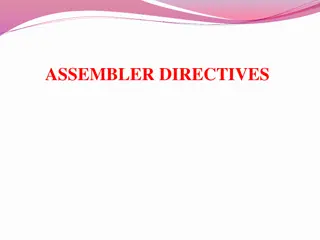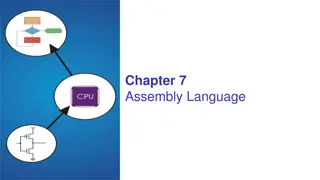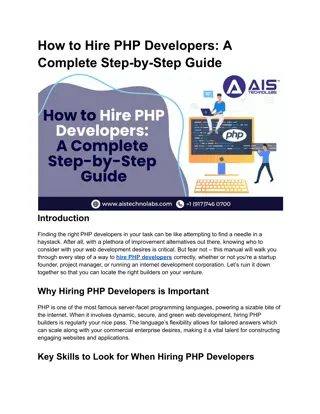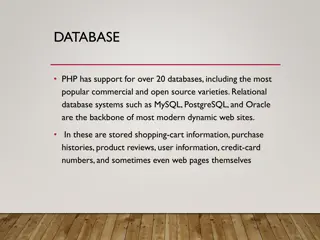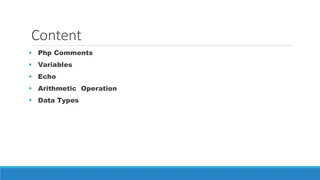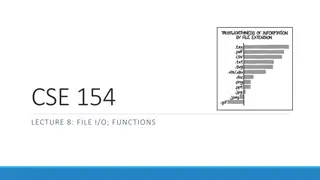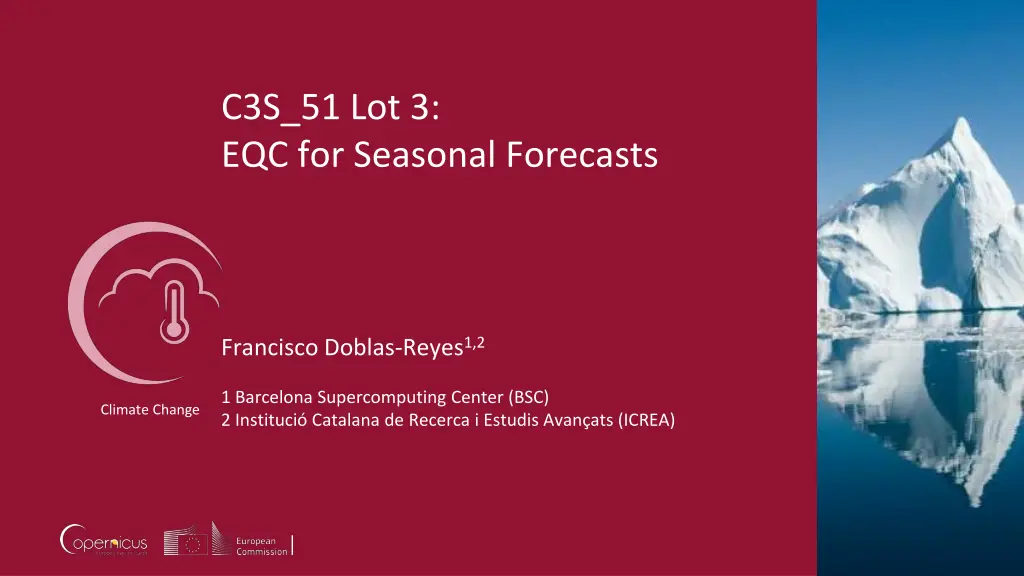
Developing Strategy for Multi-Model Seasonal Forecasts Evaluation and Quality Control
This article discusses the aims, challenges, and stakeholders involved in developing a strategy for the evaluation and quality control of multi-model seasonal forecasts by the Copernicus Climate Change Service. The strategy focuses on meeting user needs, technical and scientific assessment, quality assurance, and data sources. Various partners play essential roles in this climate change initiative.
Download Presentation

Please find below an Image/Link to download the presentation.
The content on the website is provided AS IS for your information and personal use only. It may not be sold, licensed, or shared on other websites without obtaining consent from the author. If you encounter any issues during the download, it is possible that the publisher has removed the file from their server.
You are allowed to download the files provided on this website for personal or commercial use, subject to the condition that they are used lawfully. All files are the property of their respective owners.
The content on the website is provided AS IS for your information and personal use only. It may not be sold, licensed, or shared on other websites without obtaining consent from the author.
E N D
Presentation Transcript
C3S_51 Lot 3: EQC for Seasonal Forecasts Francisco Doblas-Reyes1,2 1 Barcelona Supercomputing Center (BSC) 2 Instituci Catalana de Recerca i Estudis Avan ats (ICREA) Climate Change
Challenges of the EQC for seasonal forecasts Climate Change Adaptation: provide information for all kind of services. Consistency: build trust, ensuring a high degree of coherence across products. Innovation: transfer recent developments from research to operations. Efficiency: information should respond to users queries with a delay as short as possible. Targets: define data, products, verification, guidance, etc.
C3S_51 Lot 3: What C3S_51 Lot 3 aims at developing a strategy for the evaluation and quality control (EQC) of the multi-model seasonal forecasts provided by the Copernicus Climate Change Service (C3S) to respond to the needs identified among a wide range of stakeholders. Some important elements: Users are consulted to identify needs in terms of products and EQC information Forecast data are quality controlled and forecast products (not forecast systems) are verified A quality assurance template is required to summarise the information A framework is designed that serves as a reference to the community Climate Change
C3S_51 Lot 3: The strategy C3S_51 Lot 3 aims at developing a strategy for the evaluation and quality control (EQC) of the multi-model seasonal forecasts provided by the Copernicus Climate Change Service (C3S) to respond to the needs identified among a wide range of stakeholders. Climate Change Assessment of user needs Technical assessment and KPIs Scientific assessment Quality assurance Data sources, standards and conventions Forecast quality prototype
C3S_51 Lot 3: Who Climate Change Partner Nature Role Coordination, data inventory and EQC framework and prototype BSC-CNS (ES) Main contractor Univ. Leeds (UK) Subcontractor Assess user requirements Scientific quality assessment and gap analysis Meteoswiss (CH) Subcontractor CDS requirements and development of the prototype Subcontractor Predictia (ES) Univ. Exeter (UK) Subcontractor Expert statistical advice IFCA-CSIC (ES) Subcontractor Downscaling
C3S_51 Lot 3: The users Climate Change Yes, both qualitatively and quantitatively Yes, quantitatively (e.g. compute objective forecast quality measures) based on the hindcasts available from the same forecast system 5 Assessing forecast quality 1 11 Yes, qualitatively (e.g. visual inspection) based on past forecasts 3 Yes, using other approaches 8 No, I don't assess it myself Separate from the forecast product (i.e. information about forecast performance is presented separately): 2 Integrated into the forecast product (e.g. as strippling, contours, shading, text added to the forecast): 8 Preferences for forecast quality format 10 Masking (i.e. forecasts are only shown where they are skillful): 8 I'm not sure M. Soares (Univ. of Leeds)
C3S_51 Lot 3: Standards and metadata Climate Change All necessary metadata have been defined for the seasonal forecasts using all standards available (CHFP, SPECS). Similar standards could not be found for the reference observations. But beware xkcd.com Additional checks still necessary (data checker).
C3S_51 Lot 3: Scientific assessment 1. Forecast quality assessment Verification procedure of existing forecast systems based on scoring rules (e.g. RPS for multi-category probabilities, CRPS for ensembles) Products, and not data, are verified; forecast products are scrutinised Impact of lagged ensembles and adequate product generation 2. Calibration All bias correction and recalibration methods effectively remove bias Added value of sophisticated methods (e.g. EMOS) small to inexistent due to limited hindcast length (and low skill) 3. Multi-model combination No forecast system consistently outperforms others Multi-model combination is beneficial Avoid the temptation of identifying inadequate data sources to e.g. discard bad forecast systems. These points address questions raised by users that lead to new products Climate Change
C3S_51 Lot 3: Forecast quality assessment and calibration Climate Change Skill of JJA temperature from ECMWF SEAS5 + recalibration* Better than constant climatological forecast Worse * CRPS of JJA near-surface temperature from ECMWF SEAS 5 initialized in May calibrated with the climate-conserving recalibration (CCR) and verified against ERA Interim for 1993-2014 S. Hemri (Meteoswiss)
C3S_51 Lot 3: Forecast quality assessment and multi-model Climate Change Skill of JJA temperature from C3S multi-model* Better than constant climatological forecast Worse * CRPS of JJA near-surface temperature from ECMWF SEAS 5, Meteo France System 5, MetOffice GloSea5 initialized in May CCR + weighted (RMSE) averaging of forecast PDF and verified against ERA Interim for 1993-2014 S. Hemri (Meteoswiss)
C3S_51 Lot 3: Timeliness and provenance Computing performance and product provenance are key. Forecast verification (ROC area) with performance analysis and workflow definition using SpecsVerification and easyVerification. Climate Change J. Bedia, D. San Mart n (Predictia)
C3S_51 Lot 3: Timeliness and provenance Computing performance and product provenance are key. Users need to generate products from the forecasts. Users require bias adjustment. Computational cost estimates are fundamental for user satisfaction. Climate Change R. Manzanas (IFCA-CSIC)
C3S_51 Lot 3: Timeliness and provenance Climate Change Prepare products for reproducibility, traceability, reuse and context METACLIP ensures the reproducibility of objects (NetCDF file, image) with human and machine-readable solution http://metaclip.org. It uses an RDF-based semantic metadata model that builds the vocabularies on existing initiatives (e.g. VALUE, PROV) and stores information in JSON files. De facto the IPCC WGI standard for AR6. Visualisation of provenance information J. Bedia, D. San Mart n (PREDICTIA)
C3S_51 Lot 3: Where Quality assurance template and reports The quality information of the climate forecast datasets should be input into a quality assurance template to produce reports that are made available along with the datasets in the CDS. Reports include dataset documentation, quality flags and an independent assessment. Climate Change
C3S_51 Lot 3 The contract has documented a metadata standard to feed the common data model and created a provenance solution for products provided comprehensive forecast quality assessment of products illustrated the benefits of bias adjustment and multi-model solutions demonstrated that scalability and computational efficiency of the solutions should be taken into account to ensure timeliness identified relevant user requirements Relevant gaps: 1) guidance and context for forecast products, 2) metadata, vocabularies and provenance governance, 3) observational uncertainty, 4) criteria to identify relevant forecast products Climate Change




